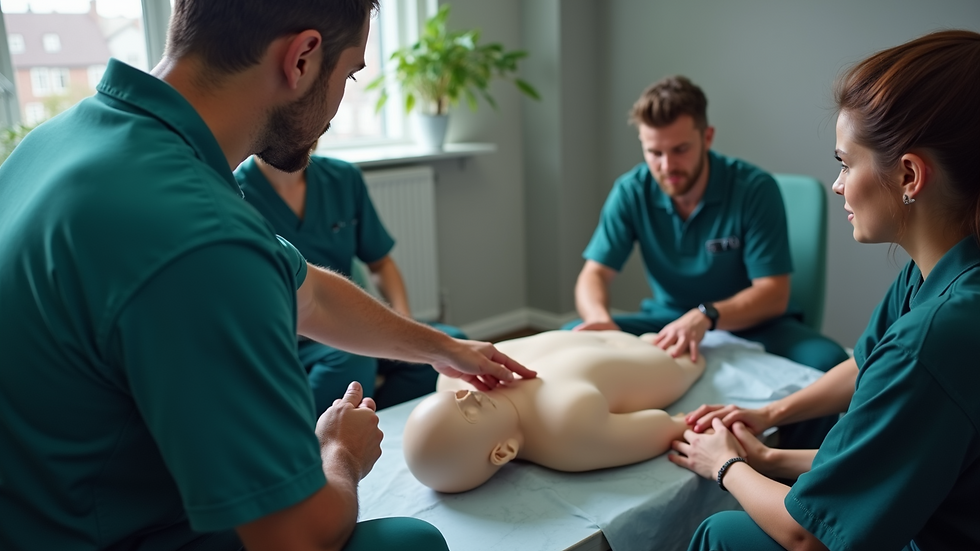What to Expect in a CPR Training Class
- Heather Smart
- Aug 17
- 3 min read
Learning CPR is a vital skill that can save lives in emergencies. Whether you are a healthcare professional, a parent, or simply someone who wants to be prepared, attending a CPR training class equips you with the knowledge and confidence to act quickly. This article will guide you through what to expect during a CPR training session, helping you feel ready and informed before you attend.
Overview of CPR Training
CPR training classes are designed to teach you how to perform cardiopulmonary resuscitation effectively. The course usually starts with an introduction to the basics of CPR, including when and why it is necessary. You will learn about the anatomy of the heart and lungs, and how CPR helps maintain blood flow and oxygen to vital organs during cardiac arrest.
The instructor will explain the different types of CPR, such as hands-only CPR and traditional CPR with rescue breaths. You will also learn about the use of automated external defibrillators (AEDs), which are devices that can restore a normal heart rhythm in some cases.
Expect a mix of theory and practical exercises. The theory part often includes videos, demonstrations, and discussions about emergency response protocols. This foundation helps you understand the importance of quick action and proper technique.

CPR mannequins are used for hands-on practice during training.
What Happens During CPR Training
During the practical portion of the class, you will get hands-on experience performing CPR on mannequins. This is where you learn the correct hand placement, compression depth, and rhythm. Instructors will guide you step-by-step and provide feedback to ensure you perform the techniques correctly.
You will practice chest compressions, rescue breaths, and the use of an AED. The instructor may simulate different emergency scenarios to help you apply your skills in a realistic context. This interactive approach builds muscle memory and confidence.
Classes often include training on how to assess the situation safely, check for responsiveness, and call for emergency help. You will also learn how to assist choking victims, which is a related life-saving skill.

Hands-on practice is essential for mastering CPR techniques.
How long does it take to become certified to teach CPR?
If you are interested in becoming a CPR instructor, the process involves additional training beyond basic CPR certification. Typically, instructor certification courses last between 2 to 4 days, depending on the organization offering the program.
During this training, you will learn how to teach CPR skills effectively, manage a classroom, and evaluate students. You will also become familiar with the latest guidelines and teaching materials. After completing the instructor course, you will be qualified to lead your own CPR training sessions and help others become certified.
Instructor certification usually requires you to already hold a current CPR certification and have some experience performing CPR. This ensures you have a solid foundation before teaching others.

Instructor-led training helps students learn CPR skills effectively.
Tips for Getting the Most Out of Your CPR Training
To maximize your learning experience, consider these practical tips:
Arrive prepared: Wear comfortable clothing that allows you to move freely. Bring a notebook and pen for taking notes.
Ask questions: Don’t hesitate to ask the instructor for clarification or additional information.
Practice actively: Engage fully in the hands-on exercises. The more you practice, the more confident you will become.
Review materials: Many courses provide handouts or online resources. Review these before and after class to reinforce your knowledge.
Stay updated: CPR guidelines can change. Plan to renew your certification every two years to stay current.
By following these tips, you will leave the class feeling ready to respond in an emergency.
Why CPR Training is Worth Your Time
CPR training is more than just a class - it is an investment in safety. Knowing how to perform CPR can make the difference between life and death in critical situations. Immediate CPR can double or triple a victim’s chance of survival.
Moreover, CPR training builds confidence. When you know what to do, you are less likely to panic and more likely to take effective action. This skill is valuable not only in professional settings but also at home, in public places, or anywhere emergencies might occur.
If you are looking for reliable and comprehensive training, consider enrolling in cpr certification classes. These classes provide expert instruction and hands-on practice to prepare you thoroughly.
Learning CPR is a proactive step toward helping others and contributing to community safety. It empowers you to be a first responder when it matters most.




Comments